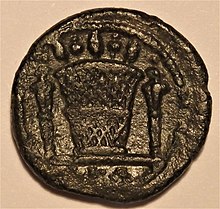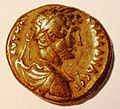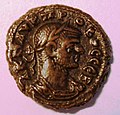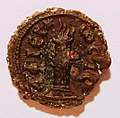Alexandrian coins
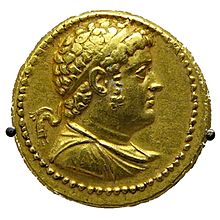
Alexandrian coins are generally all coins struck in Alexandria to this day , primarily the Greek-influenced Ptolemy coins with the likeness of the rulers, and Roman coins that were struck by almost all emperors from Augustus to the coin reform of Emperor Diocletian.
Greek coins in antiquity
Greek coins in the Archaic and Classical periods
Even before the conquest of Egypt by Alexander, coins in Northeast Africa were minted by Greeks in Cyrene and by Phoenicians in other cities of Cyrenaica , while in Egypt before Alexander there were only a few coins minted, mainly by Persian satraps . Nevertheless, Greek coins were in circulation, but initially they were only traded for their metal value, as the many coins hacked in Egyptian treasures speak for.

Greek coins in the Hellenistic period
Since the beginning of the Ptolemaic royal period in the 4th century BC With Ptolemy I in the epoch of Hellenism , only the coins minted by them were permitted as means of payment in Egypt . The Ptolemy coins were based on the Attic coin system and adopted Greek design principles. The minting in the Attic coin base made the tetradrachms weigh approx. 17 grams. The first motifs show Alexander on the portrait side and the god Zeus or the goddess Athene as Athena Alkidemos on the back. At that time, Ptolemy I saw himself only as the satrap of Alexander, even years after his death. These embossings were replaced by portraits of Ptolemy I and an eagle standing on a lightning bolt on the reverse. A legend around the eagle now designates Ptolemy as king (ΠΤΟΛΕΜΑΙΟΥ ΒΑΣΙΛΕΩΣ). The successors of Ptolemy I essentially stick to these design principles for their coinage. These Hellenistic embossing hardly show any Egyptian motifs with a few details like the elephant hood as a headdress, but appear very Greek. The lettering is also Greek, if one disregards the use of the "L" as a demotic symbol for "year". Since only a part of the Egyptian population was of Greek origin at that time, the use of almost purely Greek design principles and motifs can be seen as a contribution to the Hellenization of the entire population of Egypt.
Coins currently as a Roman province
In a narrower sense, the term Alexandrian coins means the coins that were minted for the internal currency of the province of Egypt. Geissen points out that, albeit in rare cases, the mint in Alexandria also includes coins for the province of Syria (tetradrachms for Trajan in his 12th year of reign) and Imperial Roman aurei (at the time of Vespasian and Septimius Severus ) and denarii (for Septimius Severus). The Alexandria Mint was divided into four officinae.
Domestic currency and money supply
The Romans made the practice of only allowing one internal currency with the conquest of Egypt under Augustus from the year 30 BC. BCE , which led to the fact that all foreign currencies had to be exchanged for the currency valid there when entering Alexandria . The issue initially continued in the form of the silver tetradrachm or drachm (gr. Δραχμή), which were the official currency in many Diadochian states of this epoch. It is estimated that the silver coin inventory has been roughly halved within a 50-year period between the last minting year under Cleopatra VII and the resumption of minting under Tiberius due to the general rate of loss and wear. The associated difficulties in collecting taxes made it necessary to (re-) increase the money supply. The poll tax alone, as one of many taxes, is said to have made up a volume of around 20 million tetradrachms for Egypt at that time. The total amount of money in circulation is estimated at over 75 million tetradrachms. The loss rate was not continuously supplemented. Alexandrian coins were hardly minted under Caligula. In high-volume minting years, the annual production of tetradrachms should have been a maximum of 2.5 million. In contrast to the provinces of Asia Minor, counterstamps on Alexandrian coins were unknown.
Nominal structure
The nominal system adopted by the Greeks changes in several steps. Under Emperor Tiberius , the silver dragon system was replaced by the billon tetradrachm as the most important denomination. The silver content of the coins and even their total weight are now constantly falling. The bronze coins have been minted in four denominations since Augustus, which were then expanded to six under Nero . Under Claudius , the obol with three poppy heads and two ears of wheat in one hand is used as a motif on the back, and the crocodile on the smaller dichalkum to distinguish it. Overall, however, it is difficult for many of Alexandria's bronze coins to subdivide them into a reliable system, which is why the current German-language catalog does not subdivide these coins into denominations but according to their diameter. While the first billon tetradrachms were at least similar to the earlier silver tetradrachms in their diameter of 22 to 26 mm, the diameter of the last billon tetradrachms decreased to 16 to 18 mm. Even under Tiberius, the silver content sank to 20 to 25 percent. These tetradrachms, minted towards the end of the 3rd century, even contain only 0.6 percent silver. The development towards ever lighter and less silver-containing coins is similar to that of the imperial Roman coins, which were also affected by inflation .
Motifs on coins
The Ptolemaic eagle standing on a lightning bolt was also coined as a motif, but its design was later greatly modified. The inscriptions on the coins make it clear that the divine worship of the Hellenistic kings was to be transferred to the Roman emperor. The obverse shows - with a few exceptions - the prevailing Roman emperor or a close relative (Empress son as Caesar). The lapel usually shows another portrait , images of gods, symbols or buildings. While the number of reverse motifs was still manageable under Augustus and Tiberius, the diversity of motifs increased significantly under Claudius and reached an early climax under Nero, when the coin had already fully developed its secondary function as a means of mass communication. Some coins , especially those issued in Alexandria in the 2nd century under the emperors Hadrian , Antoninus Pius , Marcus Aurelius and Commodus , show the emperor's portrait on the obverse as an outstanding motif, the Pharos of Alexandria on the lapel, alone or with Isis Pharia or with other additional motifs. These coins, mostly copper drachms or half drachms, are the only pictorial representations of the mighty seventh wonder of the world that have survived from antiquity and are therefore the only original representations that could be used for its reconstruction. The design of the coins followed primarily Greek and Roman traditions, but Egyptian motifs were taken into account to a much greater extent than in the Hellenistic period. This also includes a small copper coin that came into circulation in the 17th year of Trajan's reign and shows the Hemhem crown on the reverse . Gölitzer sees this as a clear effort so that all three major ethnic groups in Egypt feel addressed by the motifs. In addition to the pharos, sphinxes and Egyptian architectural elements such as pylons are also shown. The mixed deity of Osiris and Apis Sarapis, lord of the Nile and husband of Isis , is often used as a motif. A purely Egyptian motif from the cult of the dead are also the occasionally depicted canopic jars or, for the Egyptian religion, sacred animals such as the Apis bull, the Agathodaimon and Uraeus snake, the ibis, the crocodile and the hippopotamus. On the other hand, purely Greek motifs such as the Paris judgment continued to be imprinted in Roman times . The use of Egyptian and Greek motifs alongside the Roman ones proves the great ability of the Romans to integrate with foreign cultural influences. In addition, the consideration of regional cultural traditions will have encouraged the willingness of the population to accept Roman rule. The special importance of Egypt for securing the grain supply for Rome ( Cura annonae ) results from a series of motifs on the reverse side such as bundled field crops, a kalathos with ears of grain and poppy seed capsules or a reaper during the grain harvest. Occasional coins on the occasion of events that have little relation to Egypt, such as Nero's trip to Greece in his 13th year of reign (see Tetradrachm Nero with ship in the picture gallery) or the victories of Domitian or Claudius Gothicus over Germanic tribes, show the efforts to Egypt to be included in all-Roman events.
Gau imprints
In Alexandria, almost all coins for Egypt were made in Roman times. In addition, there were occasional so-called city and gau imprints, which also depicted the portrait of the emperor and listed his title, but also took local cults into account when using the motifs for the back. These coins can only be found since Domitian , then above all at the time of Trajan and Hadrianus and ending with Antoninus Pius and Marcus Aurelius as Caesar.
End of own coinage in antiquity
Minting of own coins for the province of Egypt came to an end in 296 AD with the reforms of the Tetrachian emperor Diocletian . Since then, only imperial Roman coins have been minted in the entire Roman territory. After the end of the Roman period and membership of the Byzantine Empire, the Byzantine currency was used , which was later replaced by Arabic coins.
Picture gallery
Hemhem-Krone Kampmann / Ganschow 27.574
Individual evidence
- ^ Eva and Wolfgang Szaivert, David R. Sear: Greek coin catalog. Volume 2: Asia and Africa. Battenberg Verlag, Munich 1983, ISBN 3-87045-187-4 , p. 309 ff.
- ↑ Geissen in: The Oxford Handbook of Greek and Roman Coinage, p. 563
- ↑ Geissen in: The Oxford Handbook of Greek and Roman Coinage, p. 562
- ↑ a b Ursula Kampmann, Thomas Ganschow: The coins of the Roman mint Alexandria. Battenberg Verlag, Regenstauf 2008, p. 16.
- ↑ A. Geissen: The Cologne coin collection. The Alexandrian coins as currency in Roman Egypt. University of Cologne, April 2, 2007, accessed on August 17, 2011 .
- ↑ E. Gölitzer: formation and development of the Alexandrian coinage. 2004, p. 104.
- ↑ Ursula Kampmann, Thomas Ganschow: The coins of the Roman mint Alexandria. Battenberg Verlag, Regenstauf 2008, p. 49.
- ↑ E. Gölitzer: formation and development of the Alexandrian coinage. 2004, p. 100.
- ↑ Geissen in: The Oxford Handbook of Greek and Roman Coinage, p. 564
- ↑ Ursula Kampmann, Thomas Ganschow: The coins of the Roman mint Alexandria. Battenberg Verlag, Regenstauf 2008, p. 47.
- ↑ Ursula Kampmann, Thomas Ganschow: The coins of the Roman mint Alexandria. Battenberg Verlag, Regenstauf 2008, p. 16.
- ^ Gisela Förschner: The coins of the Roman emperors in Alexandria. (= Small writings of the Historisches Museum Frankfurt am Main. Volume 35). Melsungen 1987, p. 35.
- ^ Gisela Förschner: The coins of the Roman emperors in Alexandria. (= Small writings of the Historisches Museum Frankfurt am Main. Volume 35). Melsungen 1987, pp. 23 and 364.
- ↑ E. Gölitzer: formation and development of the Alexandrian coinage. 2004, p. 121 f.
- ↑ E. Gölitzer: formation and development of the Alexandrian coinage. 2004, p. 113.
- ↑ Ursula Kampmann, Thomas Ganschow: The coins of the Roman mint Alexandria. Battenberg Verlag, Regenstauf 2008, p. 26.
- ↑ Geissen in: The Oxford Handbook of Greek and Roman Coinage, p. 565
- ↑ Ursula Kampmann, Thomas Ganschow: The coins of the Roman mint Alexandria. Battenberg Verlag, Regenstauf 2008, No. 35.154.
- ^ Gisela Förschner: The coins of the Roman emperors in Alexandria. (= Small writings of the Historisches Museum Frankfurt am Main. Volume 35). Melsungen 1987, pp. 44, 87 and 355.
- ↑ Ursula Kampmann, Thomas Ganschow: The coins of the Roman mint Alexandria. Battenberg Verlag, Regenstauf 2008, p. 364.
- ↑ Geissen in: The Oxford Handbook of Greek and Roman Coinage, p. 576
literature
- Gisela Förschner: The coins of the Roman emperors in Alexandria. (= Series of publications by the Historisches Museum Frankfurt am Main. Volume 35). Melsungen 1987, ISBN 3-89282-001-5 .
- Angelo Geissen, The Coinage of Roman Egypt in: William E. Metcalf, The Oxford Handbook of Greek and Roman Coinage, Oxford 2012, ISBN 978-0-19-530574-6 , p. 561-583
- Angelo Geissen , Wolfram Weiser : Catalog of Alexandrian imperial coins from the collection of the Institute for Classical Studies at the University of Cologne . (= Papyrologica Coloniensia. Volume 5). 5 volumes. Westdeutscher Verlag, Opladen 1974–1983.
- Ernst Gölitzer : Origin and development of the Alexandrian coinage from 30 BC Until the end of the Julio-Claudian dynasty. Akademie Verlag, Berlin 2004, ISBN 3-05-004089-0 .
- Ursula Kampmann , Thomas Ganschow: The coins of the Roman mint Alexandria. Battenberg Verlag, Regenstauf 2008, ISBN 978-3-86646-027-0 .
Web links
- Page on Alexandrian coins from the Roman Empire with an extensive bibliography
- Page with a large overview of Alexandrian coins from the Roman Empire
- Copper drachm (Æ), obverse Emperor Hadrian with laurel and armor, 18th year of reign 133; Revers lighthouse, Isis Pharia with sails
- Copper half-drachm, obverse Antoninus Pius with laurel wreath, 5th year of reign in 141; Revers Great Alexandria Lighthouse



